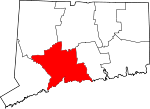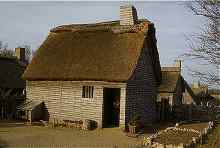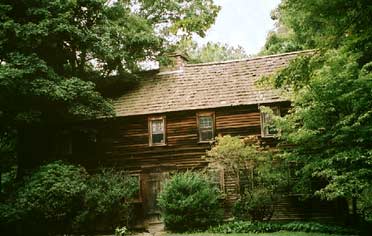The period of William2's life (1666 to 1736) marks an interesting point in Colonial history. Some historians suggest that it is in this period that the colonists were changing from “Puritans”
to “Yankees.” By the end of his life we see an expansion of setttlements through much of Connecticut with civil governments and some acceptance of 1666 William2, son of Joseph1, is born June 2, 1666 in Milford, CT. . He is the 7th child still living at the time of his mother's will in 1683. His father, Joseph1, one of the founders, will live 3 more years until Sept.11, 1669. Click for more details on this period |
7 WILLIAM2 NORTHRUP (Joseph1), b. June 2, 1666, Milford. M. Mary Peck, dau. of Joseph. Will probated, New Haven, June
28, 1736. Children b. in Milford: Perhaps
reached the age of 69 or 70. |
To William's Son Thomas in Newtown
|
||
| William2 Northrup b. 1666 |
1666 William, son of Joseph, is born June 2, 1666 in Milford, CT. |
||
| 1666 May 10, 1666 | New Haven County created. One of four original counties.  www.myconnecticutgenealogy.com/ct_county/nh.htm |
||
| 1669 William2's father dies | William2's father, the founder Joseph, dies. Is survived by his wife,William's mother, Mary. | ||
In 30 years the homes went from this   to this a 1670 Connecticut house. |
|||
|
|||
| January 22, 1673 | First ride starts to lay out the Upper Post Road. | ||
| 1675 Milford | The second mill built Milford (1675), the first fulling-mill. | ||
| 1675 Milford | Several Colonists owned two brigs for West Indian commerce and a sloop for coasting-trade. |
||
| 1678-1689 | Land is set aside for Indians at Corum Hill (part of Stratford) | ||
1683 William2's Mother dies in Milford, CT |
Mother, Mary Norton Northrup dies surviving Joseph by about 14 years.She made her will Jan. 24, 1683. | ||
| 1683 | It appears, William2's mother-in-law, Mrs.(Francis) Norton, may have survived both Joseph1(founder) and his wife,Mary Northrup. | ||
| 1683 William2 is the 7th child still living at the time of his mother's will in 1683. |
The inventory of William2's mother's (Mary Norton Northrop) estate is dated Feb. 28, 1683. The will mentions Joseph, Samuel, Jeremiah (omits John, who probably was dead), Zaphar, Daniel. William, and Mary--the latter two being in their minority-- also her mother Norton. |
||
| 1683 William about age 17 | William, one of the two still minors at the time of their mother's death 1683 would have been 17 and his younger sister, Mary, about age 13. |
||
| 1686 | 1686 – A County Road is laid out between Waterbury and New Haven through Bethany area. |
||
| 1687 Charter Oak | The political independence granted Connecticut under the
Charter of 1662 was briefly threatened in 1685 when James II attempted
to unite the New England colonies under one Royal government. This gave
rise to the Charter Oak Incident when the charter mysteriously disappeared
when all the candles went out just as it was about to be signed LINK |
||
 charter oak 1847 |
|||
 Charter Oak 1856 |
|||
| 1690 | 1690 Shipbuilding, in the old yard a few rods below the mill (Fowler’s) had already begun. Bethuel Langstaff had built in 1690 a brig of 150 tons for Alexander Bryan; another in 1695 for Boston parties. (The “Sea-Flower” for Richard Bryan was launched in 1717. The “Isabella,” an East Indian, sold in New York in 1818, was the last built at Milford) |
||
| 1690 | 1690 permission given for a ferry between milford and stratford | ||
| 1693 William2 marries about age 27 | Married Mary Peck dau. of Joseph Peck. 1693 in Milford, CT | ||
| 1694 William2 and Mary Peck's son William (3) born in Milford | 27 i William3, b. Dec. 16, 1694. |
||
| 1696 William and Mary Peck's son Ephraim born Milford, CT | 28 ii Ephraim, b. Jan. 4, 1696. |
||
| 1698 William and Mary Peck's son Joseph born in Milford | 29 iii Joseph, b. Feb. 6, 1698. |
||
| 1699 William and Mary Peck's daughter Hannah born in Milford | iv Hannah, b. Dec. 1, 1699; m. March 8, 1716, Roger Prichard, s. of Roger. Had (1) Roger, b. Dec. 25, 1716; (2) Hannah, b. Oct. 2, 718. | ||
| 1701 William and Mary Peck's son Thomas born in Milford | 30 v Thomas3 Northrup (William2, Joseph1), b. March 16, 1701 in Milford, CT. | ||
| 1701 Yale established as Collegiate School, Saybrook | At the acme of Connecticut’s educational system was Yale University, established as the Collegiate School in Saybrook in 1701 | ||
| 1703 William2 and Mary Peck's son John born in Milford | 31 vi John, b. June 17, 1703. |
||
| 1705 William2 and Mary Peck's son Job born in Milford | 32 vii Job, b. 1705. |
||
| 1705 Grist Mill built | Thirty years later(1705), a grist-mill, was built, with "two sett of stone, one for English and the other for Indian grain, and “a good boult, so yt men, if they wish, may boult ye own flour.” | ||
| 1708 William and Mary's son, Thomas would have been about 7 when approval was given for the new town, Newtowne. | In the early years of Newtown the area was known as Pohtatuck. In May 1708, the General Assembly voted that the land on the west side of Stratford or Potatuck River should become New Towne of the town of Newtowne. |
||
| Education | ” Since children reflected the fundamentally sinful nature of all men, the primary function of education was more to restrain their naturally evil impulses than to promote intellectual curiosity. | ||
| 1708 William2 and Mary Peck's daughter Ann born in Milford | viii Ann, b. 1708. | ||
| 1711 | In 1711 Pohtatuck was incorporated as the town of Newtown. | ||
| 1712 | William2 is about 46 when son moves toNewtown | ||
| 1712 | Among the residents of Newtown, in 1712, were Thomas Northrup, Benjamin and Jeremiah and John (brothers) Northrup | ||
| 1717 Yale University moves | Yale University moves from Saybrook to New Haven amidst bitterness and controversy. Founded to ensure an educated clergy for the colony, it went on to produce much of the political elite of the state including the legislature, the colonial secretary and judges of the court. | ||
| 1725 Mary Peck Northrop dies | Mary Peck Northrup dies 1725 in Milford, New Haven Co., CT She is buried next to husband William's father in the old section of Milford Center Cemetery in Milford Some sources have her death as 1728. | ||
| William dies 1735 or 6 | William2's Will probated, New Haven, June 28, 1736 Death before 28 JUN 1736 |
||
| 1736 William 2's will probated. | Will probated, New Haven, June 28, 1736. | ||
| 1738 Joel Northrop -- founding of the Parish of Amity from Milford. | Oct 1737 "Upon the memorial of Barnabas, Joel NorthrOP, Stephen Hind and
others...in the northerly part of the bounds of Milford, at a place caled
Northrop's Farms, &c praying that they may be set off from Milford
and Joyned to their neighbors living on the westerly part of the bounds
of New Haven..." |
||
| 1738 – Amity Parish is incorporated by the General Assembly of the Connecticut Colony. | The Parish territory includes most of the present townships of Bethany and Woodbridge. Amity Parish includes the Two-Bit Purchase but not the One-Bit Purchase. | ||
| 1742 – Amity Parish Congregational Meetinghouse is built | on what is now the Woodbridge Town Green; Rev. Benjamin Woodbridge is the first minister. | ||
